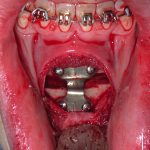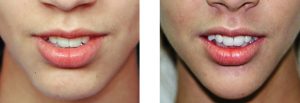The perception of a square face usually has much to do with the shape of the jaw. A square lower face is largely influenced by the width of the jaw from the chin back to the jaw angles. This may or may not be associated with a horizontally short jaw as well. While this is a common aesthetic facial concern in Orientals, it may also be seen in other ethnic groups as well. In those seeking a change from this appearance, their goal is a more narrow and slender appearing face which changes the shape from square to an oval.
The traditional approach to narrowing a wide or square lower face is jaw angle reduction surgery. An outer cortex ostectomy technique is preferred over complete angle amputation. While this can have a narrowing effect, the results are limited exclusively to the posterior part of the face where the jaw angles exist. This may not make a face appear slender as the chin and anterior jawline area unchanged. For some patients, this is an important area to combine with jaw angle reduction and is often overlooked in the surgical planning of facial slimming.


One caveat about bony chin narrowing is management of the attached soft tissues. When you have less bone support, soft tissue prolapsed and redundancies are possible. This can occur in the jowl areas as well as the floor of the mouth muscles. The genioglossus muscles must be resuspended to the chin as they are detached with central chin bone resection. The mentalis muscle should also be securely reattached to prevent any sagging of the jowls or chin pad. As it turns out, both muscles are sutured to the same place…the plate and screws used to secure the chin osteotomy in the midline.
The entire jaw contributes to a wide and square face for some patients. A narrowing sliding genioplasty can be a valuable addition to a jaw angle reduction in the goal of making a more slender jawline that has more of an oval appearance.
Dr. Barry Eppley
Indianapolis, Indiana


